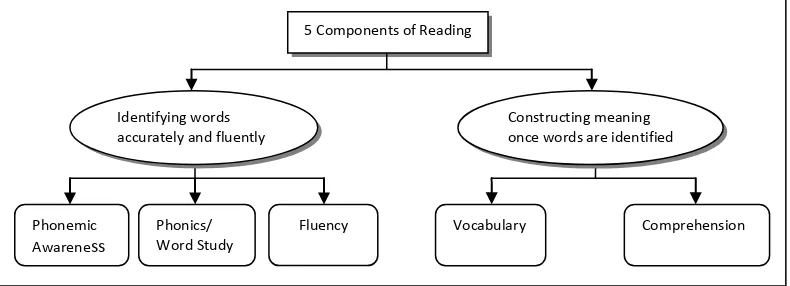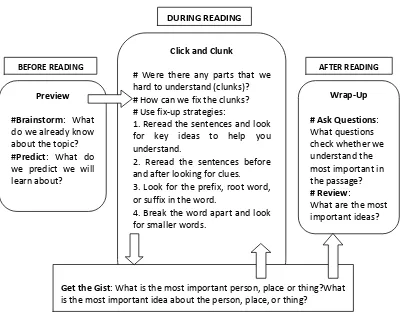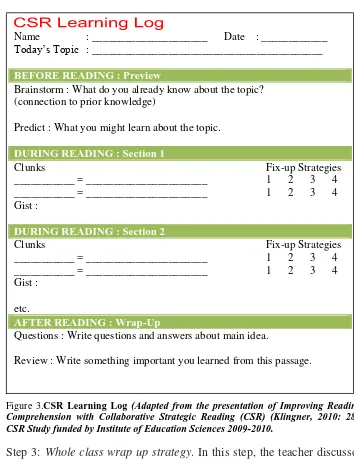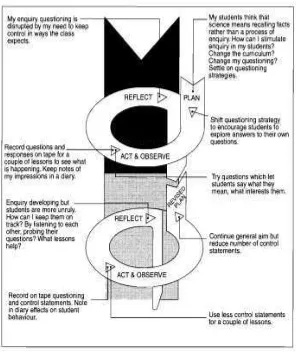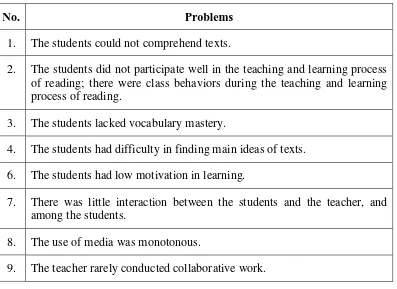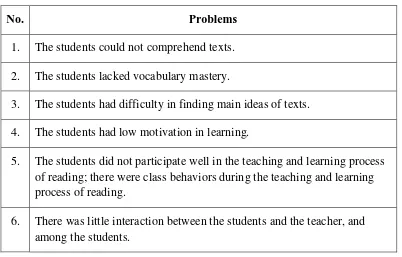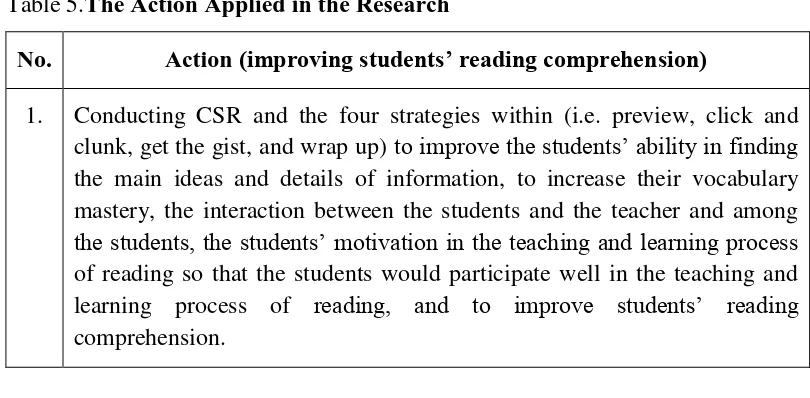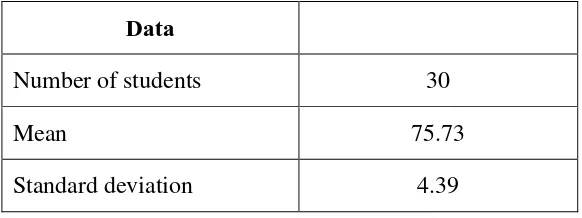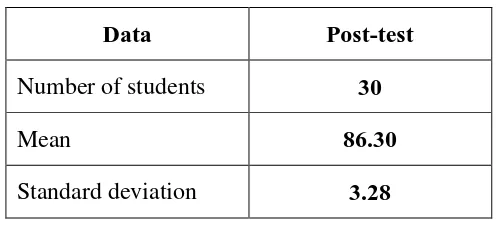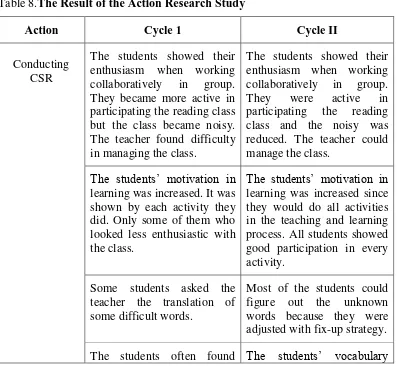CHAPTER I INTRODUCTION
This chapter concerns the background to the study, identification of the
problems, limitation of the problems, formulation of the problem, objectives of the
study, and significance of the study. Each of these is presented below.
A. Background to the Study
Reading as one of the four language skills (i.e. speaking, listening, reading
and writing) is important for senior high school students. It becomes important
since it should be mastered by senior high school students in order to reach the
aims of teaching reading in the recent curriculum namely School-Based
Curriculum or KTSP. In this curriculum, the students are expected to understand
the meaning of interpersonal and transactional written texts in the form of recount,
narrative, procedure, descriptive, news item, report, analytical exposition, hortatory
exposition, spoof, explanation, discussion, and review in daily life contexts and to
access knowledge. Besides, students are expected to be able to respond to meaning
of short functional text accurately (i.e. announcements, advertisements, invitations,
etc). Responding to the aims, most of the final exam material deals with texts. Due
to this condition, reading becomes important and students are expected to have
good understanding of the texts. To have good understanding of the texts, the
students need reading comprehension skills. In order to have good comprehension
skills, the students also need to have an ability to access integrated background
knowledge with meaning constructions as it is explored by Baddeley (2000),
Ericcson and Kintsch (1995), Verhoeven and Perfetti (2008), and Zwann and
Radvansky (1988) that successful comprehension and retention depend on the
ability to reliably access and integrate background knowledge, and the ability to
generate, maintain and update iterative forms of meaning constructions.
In practice, according to the preliminary observation conducted on July 2013
in class X.5 of SMA N 6 Yogyakarta, it was found that the students had low ability
in reading comprehension. It was reflected by some cases such as incapability in
grasping the information from the text, finding the main idea, and getting meanings
of difficult words. These problems were caused by some factors deriving from the
students and the teacher. First, the factors that came from the students’ behavior,
for example, talking to friends, texting, and browsing the internet, affected their
learning process. When the teacher asked them questions related to the text they
could not answer. This problem arose because they had less motivation and interest
in the process of teaching and learning. In addition, based on the students’ and my
point of view, there was another factor that caused students’ low motivation and
interest in the process of teaching and learning, i.e. the method used by the teacher.
The teacher gave a monotonous teaching method so that the students felt bored and
reluctant to get involved in the process of teaching and learning. When the students
felt bored and had less attention to the teaching and learning process they would
have less willingness to explore their ideas to achieve a good reading
comprehension.
In addition, based on students’ point of view, reading was important only to
English classes to pass the final exam of Semester 1 and Semester 2 without any
willingness to explore their comprehension skills in the daily activity of the
process of teaching and learning. Indeed, the students had low motivation on
reading. Most of them could not grasp the information from the texts even finding
main ideas. These common problems were influenced by the lack of vocabulary
and the inappropriate teaching technique. The inappropriate classroom teaching
technique done by the teacher diminished students’ enthusiasm about the texts.
Students with low motivation had limited vocabulary. They could not comprehend
the whole texts so that they felt bored with reading and sometimes they gave up
when they were asked to get the information in the texts. As a result, the students
turned into less active readers and at the end they become less competent in
reading skill.
Based on the situation above, it requires the use of strategies such as applying
an appropriate technique in teaching reading. One of the appropriate techniques
that can be applied in the process of reading teaching and learning is Collaborative
Strategic Reading, abbreviated as CSR. In CSR, the students will be accustomed to
collaborative peer practice and their reading skill will be gained from the
collaborative peer practice (Spielberger, 2002: 17). In CSR, all the students are
actively involved and everyone has the opportunity to contribute as a group
member to learn from and understand the text (Klingner, Vaughn, Boardman,
2007: 139). Through this activity, students are given a chance to talk much with
their friends by discussing the topic given from the teacher in a group work so that
Considering the problems above and the strength of applying CSR as a
technique in improving reading comprehension ability, the researcher developed an
observation into a scientific research under the title of Improving The Reading
Comprehension Ability of the Tenth Grade Students of SMA N 6 Yogyakarta in the Academic Year of 2013/2014 Using Collaborative Strategic Reading.
B. Identification of the Problem
To identify the problems occurred in the teaching and learning process of
reading, the researcher has conducted an observation in July 2013 in class of X.5
of SMA N 6 Yogyakarta. Based on the observation, there were found some factors
influencing the reading comprehension ability of the tenth grade students of
SMAN 6 Yogyakarta. They were the students’ vocabulary mastery, the learning
materials, the students’ interest, the students’ motivation, and the teaching
technique used in the classroom. Each problem was connected to other problems.
Based on the observation, it was found that the problem that caused other problems
was the teaching technique used in the classroom.
The conventional teaching technique did not train the students in the teaching
and learning process of reading. It did not engage all the students to the activity. A
group work was not conducted. The students were mostly demanded to read the
text aloud from the only text book, then, they were called randomly to answer the
questions by writing them on the whiteboard. This activity made the other students
(who were not called) belittle the text and did other activities. Meanwhile, the
teacher just warned the students to keep silent and pay attention to their friends
the answers of the questions based on the text. After the students answered all the
questions on the whiteboard, the teacher discussed them all with the class. The
teacher read the sentences aloud and asked the students about their meaning. When
nobody answered, he translated the sentences into Bahasa Indonesia. This teaching
technique seemed monotonous and did not boost students’ motivation to learn,
thus, they were reluctant to participate in the teaching and learning process.
This ineffective teaching technique caused class behaviors. During the
teaching and learning process, most of the students talked to their friends, played
their cell phone and some of them browsed the internet. They pretended that they
understood the text, but when the teacher asked them with the questions related to
the text, they seemed so serious to look at the text just like thinking about the
answer. They were just silent and gave no responses to the teacher’s questions.
Only some students who did the exercise on the whiteboard that could answer the
teacher’s questions while the others were just silent. This ineffective teaching
technique which de-motivated and disengaged the students in the teaching and
learning process of reading caused low comprehension.
C. Limitation of the Problem
Based on the identification of the problems stated previously, there are some
problems that can be found during the teaching and learning process. This research
is focused on improving reading comprehension through the use of Collaborative
Strategic Reading (CSR). The collaborator and the researcher limit the study on the
technique considering the reason that the technique can be a crucial case in
D. Formulation of the Problem
In line with the identification and the limitation of the problems, the
formulation of the problem of this research study is: “How can reading
comprehension ability be improved through the use of CSR?”
E. Objective of the Study
In line with the problem formulated above, the objective of this research
study is to improve the reading comprehension ability by using CSR.
F. Significance of the Study
The findings of this study are expected to give some contributions to some
parties both theoretically and practically as follows.
1. Theoretical significance
The findings of this study will give information for others about the result of the
students’ reading comprehension ability taught by CSR and can be a reference
for other researchers who want to conduct research on the same subject.
2. Practical significance
For the teachers, the findings of this study will be a valuable input in choosing
an appropriate technique in teaching reading. For the students, the findings will
7 CHAPTER II
LITERATURE REVIEW AND CONCEPTUAL FRAMEWORK
This chapter presents some theories which underline and relate closely to this
study. The discussion of this chapter is divided into two parts, i.e. literature review
and conceptual framework. In the literature review, the researcher discusses
theories which support the topic of the study. In the conceptual framework, the
researcher relates the theories mentioned previously to the focus of the study.
A.Literature Review 1. The Nature of Reading a. Definition of Reading
Reading is an interactive process between a reader and a text which leads to
automaticity or reading fluency (Alyousef, 2005: 144). In this process, the reader
interacts dynamically with the text as he/she tries to elicit the meaning, and various
kinds of knowledge being used are linguistic or systemic knowledge (through
bottom-up processing) as well as schematic knowledge (through top-down
processing).
In support to the definition above, Griffiths, Sohlberg, and Biancarosa (2011:
6) propose reading as an iterative, interactive process. It combines two processes,
i.e. bottom-up and top-down processes that are active simultaneously related to
word identification and comprehension. Regarding comprehension, Anastasiou and
perceptual, psycholinguistic and cognitive abilities that has three key components
such as accuracy, fluency (involves time), and comprehension.
In line with Anastasiou and Griva that involve fluency as one of three
components of reading that supports a reading process, Anderson (1999) in Ueta
(2005: 4) includes fluency as a part of reading. He states that reading is an active
process, fluent process, which involves the reader and the reading materials in
building meaning. Meaning does not reside on the printed page, nor is it only in the
reader.
On the other hand, Spratt, Pulverness, and Williams (2005: 21) define
reading as one of the four language skills (reading, listening, writing, and
speaking) that is categorized as a receptive skill. It is categorized as the receptive
skill because it involves responding to texts rather than producing it. Meanwhile,
Urquhart and Weir (1988) in Ueta (2005: 4) define reading as the process of
receiving and interpreting information encoded in language form. In this case, the
language form can be in sentences or texts.
In reference to the arguments above, reading can be defined as a skill that
involves the processes which engage the readers to communicate with the texts so
that they can construct meaning and grasp the information from the texts.
Reading has the main goal, i.e. to extract and to construct meaning from the
text (Anastasiou and Griva, 2009: 283). Clark and Silberstein (1977: 51) in Nunan
(2004: 53) specify the purposes of reading into four things and they should be
same in class as they are in real life. The purposes are: 1) to obtain a specific fact
(skimming), 3) to obtain a comprehensive understanding of reading, as in reading a
textbook (thorough comprehension), or 4) to evaluate information in order to
determine where it fits into our own system of beliefs (critical reading). Overall,
the ultimate goal of reading is to understand what is read.
b. Components of Reading
The components of reading help students to understand what is read. Five
components of reading as proposed by National Reading Panel (2000) in Sedita
(2010: 11) are set out in the figure below.
Figure 1.Five components of reading (Adapted from National Reading Panel (2000) in Sedita (2010:11)).
The figure above shows five components of reading. They are phonemic
awareness, phonics/word study, fluency, vocabulary, and comprehension.
Phonemic awareness involves the ability to notice, think about, and work with the
individual sounds in spoken words. Before students learn to read, they must
understand how the sounds in words work. Phonics is related to the ability to
understand the relationship between the letters of written language and the
individual sounds of spoken language. It includes the use of letter combinations
and patterns, syllable types, and skills to read and spell words. Fluency is the
ability to read text quickly, accurately, and automatically, with proper expression 5 Components of Reading
Identifying words
accurately and fluently Constructing meaning once words are identified
Phonemic Awareness
Phonics/ Word Study
and understanding. Vocabulary involves the ability to understand the meaning of
words. While comprehension is the ability to derive meaning based on the
information in the text. In order to derive meaning in the text, the reader‘s own
knowledge is needed to use. Comprehension can be improved by teaching students
using specific reading strategies.
Based on the figure above, the first three components (phonemic awareness,
phonics/word study, and fluency) are necessary for basic decoding. They allow
readers to identify and spell words accurately and fluently. The last two
components (vocabulary and comprehension) enable readers to construct meaning
once words are identified. These last components have a strong effect on
understanding what is read.
In the same field, Alderson (2000) in Liu (2010) reinforces the argument
about the two last components above by proposing two components of reading.
They are decoding (word recognition) and comprehension. Besides these two
components, vocabulary is also a considered part in reading.
In the different opinion, Alliance for Excellent Education (2004: 4) provides
two important components to improving students‘ comprehension. They are prior
knowledge and strategy instruction. Prior knowledge leads students to connect
material in a text to their own experiences and create a foundation for them to read
text effectively. Such connection is often used for making references and
prediction. Besides the prior knowledge, reading comprehension instruction can be
useful in improving students‘ reading comprehension. It provides the students with
and how to use it. Through comprehension strategy instruction, students learn a set
of useful tools that allow them to improve their reading comprehension.
c. Reading Skills and Strategies
To make the concept of reading clear, the researcher needs to explore the
differences between reading skills and strategies. Besides reading skills, reading
strategies are one of pre-requisites needed in order to comprehend the texts. The
differences of each are presented by the following definition.
Reading skill is an important tool that students need to become academically
successful. The school curriculum allows texts to use in order to acquire the
information. Therefore, when reading a text the goal is to understand its content. In
this case, skills are seen as parts of the generalized reading process (Liu, 2010:
153). By having the skills, students will have a good reading competence. They
will get fewer difficulties when they do a reading activity.
Urquhart & Weir (1998) cited in Liu (2010: 153) describe a reading skill as
―a cognitive ability which a person is able to use when interacting with texts.‖
When interacting with the texts, a reader (i.e. a student) uses his/her cognitive
ability in order to grasp the information even to comprehend them.
Reading skills have some sub-skills, i.e. scanning (reading for specific
information), skimming (reading for gist), reading for detail, and approaches such
as extensive reading and intensive reading. When scanning, the readers do not read
the whole text. They just quickly read most of the text until they find the
text to get a general idea of what it is about. Another sub-skill is reading for detail.
This sub-skill engages the readers to get the meaning out of every word.
Another approach is extensive reading. Extensive reading involves reading
long pieces of text, for example, a story and an article. Besides, there is intensive
reading. In an intensive reading, the texts are used to examine the language.
Learners are asked to look for all the words in the text related to a particular topic,
or work out the grammar of a particular sentence. This activity is aimed at making
learners more aware of how language is used. These sub-skills influence how
readers read (Spratt, Pulverness, and Williams, 2005: 22).
Different from the definition of reading skills, a reading strategy is a plan or a
way of doing something; a specific procedure one uses to perform a skill (Hollas,
2002). In this case, strategies are used to help learners focus on reading and to do
more than just read the words on a piece of paper. Furthermore, he suggests that to
improve the effectiveness of each reader, the skills of a strategic reader in the
content areas can be broken down into seven areas as follows.
1. Predicting – declaring in advance or to foretell on the basis of observation
and/or experience.
2. Visualizing – forming mental pictures of scenes, characters and events.
3. Connecting – to link two things together or to associate and see a
relationship.
4. Questioning – to inquire or examine.
5. Clarifying – to make understandable or to become clear and free of
6. Summarizing – to concisely obtain the essence or main point of the text.
7. Evaluating – to form an opinion about what you have read.
The predicting, visualizing, and connecting areas are implemented as before
reading strategies. They are used to promote students‘ interest and involvement in
the upcoming assignment. These kinds of strategies help the students to activate
their prior background knowledge so that the learner can begin to make a
connection to the reading. The question and clarification areas are implemented as
during reading strategies. These strategies are used to help reinforce
comprehension and maintain self-interest. These particular strategies help the
students engage personally and respond to the text, consolidate ideas, and find a
reason for the sequence of information. While summarizing and evaluating are
implemented as after reading strategies. These strategies are used by the student to
thoroughly understand what they have just read. The evaluation and summarizing
process allow the students to recall the information from the texts they have read.
d. Macro and micro-skills for reading
In order to be efficient readers, students need macro and micro-skills.
According to Brown (2004:187), there is a list of some important micro-skills that
learners should use in reading. The micro-skills include some items as follows.
1) Discriminating among the distinctive graphemes and orthographic patterns of
English.
2) Retaining chunks of language of different lengths in short-term memory.
4) Recognizing a core of words, and interpreting word order patterns and their
significance.
5) Recognizing grammatical word classes (nouns, verbs, etc.), system (e.g. tense,
agreement, pluralization), patterns, rules, and elliptical forms.
6) Recognizing that a particular meaning may be expressed in different
grammatical forms.
7) Recognizing cohesive devices in written discourse and their role in signaling
the relationship between and among clauses.
The macro-skills include some issues presented below:
1) Recognizing the rhetorical forms of written discourse and their significance for
interpretation.
2) Recognizing the communicative function of written texts, according to form
and purpose.
3) Inferring context that is not explicit by using background knowledge.
4) Describing events, ideas, etc., inferring link and connection between events,
deducing cause and effects, and detecting such relations as main idea,
supporting idea, new information, given information, generalization, and
exemplification.
5) Distinguishing between literal and implied meanings.
6) Detecting culturally specific references and interpreting them in a context of
7) Developing and using battery of reading strategies, such as scanning and
skimming, detecting discourse markers, guessing the meaning of words from
context, and activating schemata for the interpretation of texts.
e. Types of Reading Performance
There are two types of classroom reading performance as proposed by Brown
(2001:312), i.e. oral and silent reading. Oral reading is suitable for beginning and
intermediate levels and commonly used as a pronunciation test. While silent
reading is divided into extensive and intensive reading. The definition of extensive
and intensive reading can be derived from the differences between them as
proposed by Hafiz and Tudor (1989: 5) in Alyousef (2005: 147), that is:
In intensive reading activities learners are in the main exposed to relatively short texts which are used either to exemplify specific aspects of the lexical, syntactic or discoursal system of the L2, or to provide the basis for targeted reading strategy practice; the goal of extensive reading, on the other hand, is to ‗flood‘ learners with large quantities of L2 input with few or possibly no specific tasks to perform on this material.
Specifically, extensive reading involves reading long pieces of text, for
example, a story and an article. While in an intensive reading, the texts are used to
examine the language. For example, learners are asked to look for all the words in
the text related to a particular topic, or work out the grammar of a particular
sentence. Extensive and intensive reading influence how the readers read and both
of them is aimed at making learners more aware of how language is used (Spratt,
2. Reading Comprehension
a. Definition of Reading Comprehension
Comprehension is a complex process that has been understood and explained
in a number of ways. Comprehension is seen as a complex process as proposed by
Duke and Pearson (2002: 1) that it is consuming, continuous, and provides
complex activity, but it is satisfying and productive for good readers.
According to Snow (2002: 11), comprehension is ―the process of
simultaneously extracting and constructing meaning through interaction and
involvement with written language‖. This process is seen as an interactive process
that consists of three elements: the text as being comprehended, the reader that is
doing the comprehending, and the activity in which comprehension is a part, as it
is proposed in the definition of reading comprehension.
In line with Snow, Pardo (2004: 272) states that comprehension is a process
in which readers construct meaning from texts. In order to construct meaning, the
readers are interacting with the texts through the combination of their prior
knowledge and previous experience, information in the text, and the stance how
the readers connect with the texts.
In reference to the definitions above, reading comprehension is a process that
enables readers to actively interact with the texts through communicative way in
order to get meaning from the texts.
Comprehension processes result in three levels of representation of a text‘s
meaning. They are sentence level representation, proposition level of
The sentence level representation is literally a word-for-word rendering of the text
being read. While the proposition level of representation is a level in which the
reader extracts the core ideas from the literal text. In this level, with word meaning
available, syntax is parsed to establish relations between words leading to
construction proposition level meaning. The highest level representation of a text‘s
meaning i.e. the situation model that represents the integrated situation described in
a text. Situation models describe the representation constructed when readers
integrate and update what they already know about the topic into a more complex
and holistic conceptualization of it. Specifically, reading comprehension depends
upon a number of cognitive processes. Griffiths, Sohlberg, and Biancarosa (2011:
12) add that the readers must be able to ―hold onto‖ new information as it is being
read, while retrieving relevant information from background knowledge and the
readers must integrate information to construct representation of meaning.
b. Factors Affecting Reading Comprehension
In teaching reading comprehension, a teacher should be aware of some
factors because the success or the failure of reading comprehension can be affected
by some factors such as meta-cognition, decoding/fluency, knowledge, and
vocabulary and language skills (Sedita, 2010: 13).
The meta-cognition factor is closely related to motivation. Weak
self-monitoring skills and a lack of useful strategies can impede reading
comprehension. Furthermore, students will be more successful in reading
comprehension if they are motivated to understand and engage in text they read
of poor reading comprehension. When the students have weaknesses in these areas,
they are unable to focus on comprehending what they are reading.
The next factor is knowledge. In this case, knowledge is related to
background knowledge and knowledge of text structure. A lack of life experience
or vast reading experience can affect the amount of background knowledge that the
students can access when they are reading because without sufficient background
knowledge they cannot relate to the information to construct meaning. In order to
comprehend the texts, a reader must have knowledge of text structure at the
sentence, paragraph, and discourse levels. They must be able to understand each
sentence and to link the ideas from one sentence to others. In support to this,
Carlisle and Rice (2002) in Sedita (2010: 13) propose that students who have good
grammatical awareness tend to be good readers.
Besides meta-cognition, decoding/fluency, knowledge, and vocabulary, the
success or the failure of reading comprehension can be affected by other factors
such as vocabulary and language skills. Mastery of vocabulary has strong
relationship with reading comprehension. This relationship arises since the texts
entail recognizing words even comprehending the texts. Thus, a reader with wide
vocabulary will be able to recognize words in the texts so that he/she has
possibility to easily comprehend the texts rather than them who lacks of
vocabulary.
Based on the factors above, there are some learning weaknesses that the
attention, short or long-term memory, visualizing and creating images, expressive
language skills, and English as a second language (Sedita, 2010: 14).
c. Problems in Reading Comprehension
The capability of being able to comprehend the texts is not easy to achieve.
Students who do not have a strong foundation in comprehension skills become
struggling readers and are often caught in a cycle of failure. They become those
students because they find that reading is very difficult to learn.
One of the problems faced by the students is the linguistics knowledge of
English text. In this case, it is often difficult to prove, for the students of English as
a foreign language, that texts in English can be understood even though there are
structures that the students have never seen before. Hedge (2000: 192) proposed
that in processing texts, the second language readers will find difficulties when
they find unfamiliar aspects of the English language. For example, the inability to
understand cohesive devices in a text will impede their understanding of the
relationships of sentences. Accordingly, cohesive devices include such things as
reference items (for example, ‗they‘ and ‗this‘), lexical cohesion through a chain of
synonyms (for example, ‗funding … financing … resourcing‘), or deletion of items
such as relative pronouns (for example, ‗which‘ and ‗that‘). By understanding
language knowledge, the learners find it easier to grasp the meaning of a particular
text.
Another major difficulty that may be experienced by the students of English
as a foreign language in mastering reading skill is the lack of vocabulary items. If
understand in acquiring a great number of vocabulary items and they need to
recognize about 95 percent of the words they might encounter in text for
instructional purposes (Grabe, 2009: 333). In line with it, Nations (2006) in Grabe
(2009: 333) insists that independent fluent reading generally occurs when a reader
can recognize 98-99 percent of the words in a given text. However, it is often
found that most learners worry about the meaning of a particular word in a text
being read. Therefore, they never achieve the minimum standard of mastery level
to read texts in English. Furthermore, most of them have not found the urge of
English for their field of study. As a result, they will feel unmotivated in learning
English.
On the other hand, a number of problems are also faced by the teachers. The
teachers find the difficulty in the teaching reading. One of them deals with learning
strategy. An appropriate strategy, which provides interesting activities, will
encourage students to be active, and realize the demand they are supposed to have.
In this case, the teachers have not found the appropriate strategy to use in teaching
reading. Since they do not find the appropriate strategy to teach, the students pay
less attention to the teacher, they are less active in the classroom, and have their
own activity with friends during the process of teaching and learning. The teacher
then may find it difficult to control the class. As a result, the teaching and learning
process do not run well.
Dealing with the problems above, the researcher needs to apply a certain
technique and strategy to overcome the problems. In this case, the technique
is effective with students including language minority students. In order to solve
the EFL classroom‘s problems on reading comprehension, the technique is
expected to give some benefits to learning process such as motivating the students,
improving social interaction in the classroom, creating a positive learning
environment, and improving reading skills.
d. Strategies for Reading Comprehension
For most second language learners who are already literate in a previous
language, reading comprehension is primarily a matter of developing appropriate
and efficient comprehension strategies. Comprehension strategies are also regarded
as deliberate and goal oriented processes used to construct meaning from text
(Abidin and Riswanto, 2012: 192). Some strategies are related to bottom-up
procedures and others are related to top-down processes. The following are ten
strategies that can be applied as classroom techniques (Brown, 2001):
1. Identifying the purpose of reading (clearly identify the purpose in reading something so you will know what you are looking for);
2. Using graphemic rules and pat terns to aid bottom-up decoding, especially for beginning level learners;
3. Using efficient silent reading techniques for rapid comprehension (for intermediate to advanced levels);
4. Skimming the text for main ideas (quickly running one‘s eyes across whole text for its gist) for prediction;
5. Scanning the text for specific information (quickly searching for some particular piece or pieces of information in a text); 6. Using semantic mapping or clustering (grouping ideas into
meaningful clusters, helps readers to provide some order to the chaos);
7. Guessing when you aren‘t certain (guess a meaning of a word, guess a grammatical relationship, guess a discourse relationship, infer implied meaning, guess about a cultural reference and guess content messages);
contexts that may signal information, look at semantic context for clues);
9. Distinguishing between literal and implied meanings; 10. Capitalizing on discourse markers to process relationships.
Considering comprehensive reading strategies, Lai (1997) cited in Nunan
(2004: 62-63) presents some strategies for reading. He proposes that by matching
strategies, texts and reading purposes it is possible for second language readers to
significantly increase both their reading speed and their comprehension. The
strategies and the explanation are set out in the table below.
Strategy Explanation
1. Having a purpose
It is important for students to have a clear purpose and to keep in mind what they want to gain from the text.
2.Previewing Conducting a quick survey of the text to identify the topic, the main idea, and the organization of the text.
3.Skimming Looking quickly through the text to get a general idea of what it is about.
4. Scanning Looking quickly through a text in order to locate specific information.
5.Clustering Reading clusters of words as a unit. 6. Avoiding bad
habits
Avoiding habits such as reading word by word.
7.Predicting Anticipating what is to come. 8. Reading
actively
Asking questions and then reading for answers.
9. Inferring Identifying ideas that are not explicitly stated. 10.Identifying
genres
Identifying the overall organizational pattern of a text.
11.Identifying paragraph
Table1. Reading Strategies (Adapted from Lai (1997) in Nunan (2004: 62-63))
Good readers will adjust their strategies to the type of text they read and to
the purpose for which they are reading (Anastasiou and Griva, 2009: 283). They
will distinguish between important information and details as they read and are
able to relate new information with information already stated. They employ
strategies then to make it understandable.
e. Techniques in Teaching Reading Comprehension
Considering the problems found in reading comprehension, the researcher
feels that it is necessary to provide a model of teaching strategy as a technique in
teaching reading comprehension, as mentioned in the previous section, that it may 12. Identifying
sentence structure
Identifying the subject and main verb incomplex sentences.
13. Noticing cohesive devices
Assigning correct referents to proforms (they can be pronouns), and identifying the function of conjunctions.
14. Inferring unknown vocabulary
Using context as well as parts of words (e.g. prefixes, suffixes and stems) to work out the meaning of unknown words.
15. Identifying figurative language
Understanding the use of figurative language and metaphors.
16. Using background knowledge
Using what one already knows to understand new ideas.
17. Identifying style andits purpose
Understanding the writer‘s purpose in using different stylistic devices such as a series of short or long sentences.
18. Evaluating Reading critically, and assessing the truth value of textual information.
19. Integrating Tracking ideas that are developed across the text through techniques such as highlighting and note-taking.
20. Reviewing Looking back over a text and summarizing it.
21. Reading to present
help students create a good learning atmosphere to take part actively in the
classroom activity in order to improve their reading comprehension.
Regarding the techniques in teaching reading comprehension, some experts
proposed different ideas. The most common idea is advanced by Brown (2001:
299) that there are three techniques in teaching reading comprehension, i.e.
bottom-up processing, top-down processing and interactive processing.
1) Bottom-up processing
In bottom-up processing the readers construct meaning from the smallest unit,
i.e. from letters, words, phrases, and sentences. In this process, the readers build up
a meaning from the written words on the page. The readers recognize letters,
words, and working out sentence structure.
2) Top-down processing
Top-down processing requires the reader to interpret the text by moving from
the highest to the lowest unit analysis. Here, the reader makes use of his existing
knowledge to predict the meanings of the texts (Goodman in Alderson, 2000: 17).
3) Interactive processing
This processing is the combination of top-down processing and bottom-up
processing. This process allows the readers to use both bottom-up and top-down
processing in turn or at the same time. The readers can adopt a top-down
processing to activate their background knowledge, then, move to the bottom-up
processing by focusing on the smallest unit. The movements from one to another
are based on the type of text as well as on the reader‘s background knowledge,
In order to get the success of reading comprehension, the reader needs the
most suitable strategy that includes the approaches above to get the final purpose in
reading the text.
3. Collaborative Strategic Reading (CSR)
CSR is a reading comprehension strategy that combines modification of
reciprocal teaching and cooperative learning strategy or student pairing (Vaughn,
2002: 1). In reciprocal teaching, teachers and students take turns leading a dialogue
concerning key features of text through summarizing, questioning, clarifying, and
predicting. This definition is supported by Grabe (2009: 233) that claims CSR as a
promising approach to combined strategies instruction that draws on both
reciprocal teaching and cooperative learning, and that has been used with both L1
and L2 students. It provides readers with dual reading approaches simultaneously,
bottom up and top down model.
In a more specific way, Spielberger (2002: 17) exclaims that CSR combines
instruction in comprehension strategies and study skills with collaborative peer
practice. Here, students learn four strategies through direct instruction and teacher
modeling such as preview (i.e., preview and predicting), click and clunk (i.e.,
monitoring for understanding and vocabulary knowledge), get the gist (i.e.,
understanding the main idea, and wrap-up (i.e., self questioning for understanding).
In CSR, students learn pre-reading, during-reading, and post-reading
During reading, they deal with click and clunk and get the gist, while after reading
they have wrap-up activity. Each of these strategies is briefly explained as follows.
1) Preview – before reading
Preview allows students to generate interest and activate background knowledge in
order to predict what they will learn. In other words, the students are asked to
brainstorm what they already know about a topic and predict what they think they
will learn.
2) Click and Clunk – during reading
In this strategy, the students monitor their comprehension and apply fix-up
strategies to help them figure out unknown words when comprehension breaks
down. In other words, click and clunk are self-monitoring strategy which controls
students understanding about words, concepts and ideas that they understand or do
not understand, or need to know more about.
3) Get the Gist – during reading
In this strategy, students identify the most important ideas about a topic in a section
of text to confirm their understanding of the information.
4) Wrap Up – after reading
This strategy provides students with an opportunity to wrap up by generating
The four strategies above are drawn into the CSR‘s plan, set out in the
following diagram.
Figure 2. CSR’s Plan for Strategic Reading (Adapted from Klingner (2010) in International Journal of Humanities and Social Science (2012: 193))
CSR can be implemented in two phases, i.e. teaching the strategies, and
cooperative learning group activity or student pairing (Vaughn, 2002: 2). In the
first phase, teaching the strategies, students learn four strategies i.e. preview, click
and clunk, get the gist, and wrap up as explained before. In the second phase,
cooperative learning group activity or student pairing, students have learned the
four strategies (preview, click and clunk, get the gist, and wrap up) and they are
ready to apply CSR in their peer-led cooperative learning groups. Preview
#Brainstorm: What do we already know about the topic? #Predict: What do we predict we will learn about?
Click and Clunk
# Were there any parts that we hard to understand (clunks)? # How can we fix the clunks? # Use fix-up strategies:
1. Reread the sentences and look for key ideas to help you understand.
2. Reread the sentences before and after looking for clues. 3. Look for the prefix, root word, or suffix in the word.
4. Break the word apart and look for smaller words.
Wrap-Up
# Ask Questions: What questions check whether we understand the most important in the passage? # Review:
What are the most important ideas?
Get the Gist: What is the most important person, place or thing?What is the most important idea about the person, place, or thing?
BEFORE READING
DURING READING
The procedures for using in groups are outlined below.
1) Set the stage
The teacher assigns students to groups of four of varying ability. Then, the
teacher assigns roles to students. Students can take the roles in turn so that they can
experience a variety of roles. The roles include leader, clunk expert, gist expert,
and announcer.
Leader. The leader should tell the group what to read next and what strategy
to use next.
Clunk Expert. He/she uses clunk cards to remind the group of the steps to
follow when trying to figure out the meaning of their clunk(s).
Gist Expert. He/she should guide the group toward getting the gist and
determines that the gist contains the most important idea(s) but no unnecessary
details.
Announcer. He/she calls on group members to read a passage or share an
idea.
2) Process
The steps to apply CSR in a cooperative learning group are as follows:
a) Step 1: Whole class introduction. In this step, the teacher introduces the
topic, teaches key vocabulary, and provides instructions.
b) Step 2: Cooperative group activity during preview, click and clunk, get
the gist, and wrap up).In this step, each group member plays an assigned
Name : _____________________ Date : ____________ Today‘s Topic : __________________________________________
BEFORE READING : Preview
Brainstorm : What do you already know about the topic? (connection to prior knowledge)
Predict : What you might learn about the topic.
DURING READING : Section 1
Clunks Fix-up Strategies
___________ = ______________________ 1 2 3 4 ___________ = ______________________ 1 2 3 4 Gist :
DURING READING : Section 2
Clunks Fix-up Strategies
___________ = ______________________ 1 2 3 4 ___________ = ______________________ 1 2 3 4 Gist :
etc.
AFTER READING : Wrap-Up
Questions : Write questions and answers about main idea.
Review : Write something important you learned from this passage.
The CSR learning log is set out below:
Figure 3.CSR Learning Log (Adapted from the presentation of Improving Reading Comprehension with Collaborative Strategic Reading (CSR) (Klingner, 2010: 28), CSR Study funded by Institute of Education Sciences 2009-2010.
c) Step 3: Whole class wrap up strategy. In this step, the teacher discusses
the reading passage, reviews clunks, answers questions, or shares some
review ideas.
Principally, the goals of CSR are to improve reading comprehension and to
increase conceptual learning in ways that maximize students‘ involvement in the
teaching and learning process. The cooperative learning concept in CSR promotes
learning goals (Abidin and Riswanto, 2012: 193). The goal of CSR and the concept
within lead the use of CSR in the classroom especially in classroom teaching
reading comprehension. Besides, the benefits of CSR (that engages students to
work in small group cooperatively so they have opportunity to discuss and share
the ideas among the members of the groups as well as develop their social skills)
and cooperative learning techniques also take part in the use of it. The benefits of
cooperative learning techniques as proposed by Johnson & Johnson (1987) and
Slavin (1995) in Abidin and Riswanto (2012: 193) are promoting student and
academic achievement, increasing students‘ retention, enhancing student
satisfaction with their learning experience, help the students develop skills in oral
communication, developing students‘ social skills, promoting students‘ self–
esteem, and help the students to promote positive race relation.
4. Teaching Reading Comprehension
a. Teaching Reading Comprehension in Senior High School
Teaching is showing or helping someone to learn how to do something,
giving instructions, guiding in the study of something, providing with knowledge,
and causing to know or understand (Brown, 2007: 8). It implies that teaching is a
tool for guiding and facilitating learning, enabling the learner to learn, and setting
condition for learning.
Teaching reading means guiding and facilitating learners to read, enabling
the learners to read, and setting condition to read. The teacher‘s apprehension of
the learners will determine the teacher‘s philosophy of education, teaching style
Teaching reading in senior high school is challenging for the English teacher.
It becomes challenging since the exam is about text and the aim of the teaching
reading that is stated in the recent curriculum. In the recent curriculum namely
School-Based Curriculum or KTSP, the students are expected to understand the
meaning of interpersonal and transactional written text in the form of recount,
narrative, procedure, descriptive, news item, report, analytical exposition, hortatory
exposition, spoof, explanation, discussion, and review in daily life contexts and to
access knowledge. It means that students are not only expected to understand the
texts but also to link them with the daily life contexts and to access knowledge
from them. This ability then is tested in the final exam. Most of the final exam is
dealing with texts. Thus, it brings the students to have a good reading
comprehension.
Teaching reading comprehension in senior high school is different. When
teaching reading for senior high school students, the teacher does not teach the
students to learn to read only, but also to teach them to read to learn. In order to
urge the students to have a good reading comprehension, the English teacher needs
to provide the best technique in teaching reading while apprehends the
characteristics of the students and the situation in the classroom, facilitates the
students with appropriate and challenging situation, and considers all factors that
can affect students‘ reading comprehension so that their ability in reading
b. Reading Comprehension Assessment
Assessment is the process of observing and measuring learning (Penn: 2012).
Teachers use assessment in reading to make sure that students are making
measurable progress. They evaluate a student's level of achievement and skill for
the purpose of supporting and improving students‘ learning.
Regarding a measure, in selecting a test or assessment procedure, it is important
to select a measure that closely matches the users‘ needs or purpose. According to
Klingner (2007: 17), teachers should consider numerous factors when choosing a test
or assessment procedure. Those factors are presented as follows.
1) The purpose of the testing (screening, progress monitoring, assessing level of reading, research, or assessing students‘ competence in comparison to peers).
2) The specific information needed about the student‘s reading comprehension (types of questions missed, level).
3) The number of students being tested (i.e., an individual, a small group, or a whole class).
4) The length of the test (e.g., shorter tests can be easier to give and less stressful for the student, but may not have enough questions or types of tasks to provide sufficient information about a student‘s performance).
5) Whether the test is an individually or group-administered test. 6) The number of forms available with the test, particularly if
multiple administrations are needed (e.g., many norm-referenced tests come with two forms, making them useful for assessing progress over time—students are given one version of the test as a pretest and another as a posttest).
7) For norm-referenced tests, the extent to which the norming sample is similar to the students to whom the test will be administered.
8) The examiner‘s qualifications (e.g., whether the tester has the skills to give highly specific tests).
B.Relevant Studies
There are some studies related to this study that were previously conducted
by other researchers. The first researchers are Klinger and Vaughn. They
conducted the research in 1998 with 26 seventh and eighth graders with low
learning abilities who used English as a second language. In this study, students
learn to use modified reciprocal teaching methods in cooperative learning groups
(i.e., brainstorm, predict, clarify words and phrases, highlight main idea,
summarize main ideas and important detail, and ask and answer the questions). It
was found that CSR was effective in improving reading comprehension for most of
the students with low learning abilities. In 2000, they implemented CSR with
fourth graders with a wide range of reading levels. Students in the CSR group
significantly outperformed those in the control group on comprehension. In a
subsequent study, fifth grade students were taught to apply CSR by trained
classroom teachers during English as a Second Language (ESL) science classes. It
was shown that the students significantly increased their vocabulary from pre- to
post-testing. Furthermore, students in CSR groups spent greater amounts of time
engaged in academic related strategic discussion and assisted one and another
while using CSR.
The second researcher is Fan who conducted a research in 2010. The research
was conducted on 110 Taiwanese students from two intact classes. The purpose of
the research is to investigate the impact of CSR towards EFL Taiwanese students‘
reading comprehension. The questionnaire and standardized reading pre-test,
the statistical results confirm CSR was more effective than the traditional
teacher-led reading approach which focuses on vocabulary and grammar teaching in
improving the students‘ reading comprehension scores. The findings indicated that
CSR had a positive effect on the Taiwanese university learners‘ reading
comprehension particularly in relation to the comprehension questions on getting
the main idea and finding the supporting details. Moreover, a detailed analysis of
qualitative data suggested that the learners with relatively homogenous English
ability provided collaborative scaffolding for comprehension texts through
co-construction, elaboration, and appeal for assistance, corrective feedback, and
prompts.
The third researcher is Wang who did the research in 2008. He examined the
effect of CSR on sixth-graders‘ reading comprehension and learning attitudes.
Sixty-two pupils from two intact classes were divided into a control group
receiving the traditional teacher-directed reading instruction and an experimental
group of CSR instruction in combination with story retelling strategy training for
fifteen weeks. Multiple measures were used in this study. They consisted of a
questionnaire of English learning background, pre-tests and post-tests of reading
comprehension, five post-tests administered after reading stories, a story reading
post-test which students had not ever read in the class and a questionnaire of
students‘ attitudes towards the intervention. It was reported that modified CSR
approach was effective in fostering her six-graders‘ overall reading comprehension
and understanding of the meaning of the stories, and that it increased their English
This research is a bit different from those previous ones. It observes 30 tenth
grade students of a senior high school with low reading comprehension. This
research was conducted in the classroom action research that used specific texts
(i.e. narrative and recount texts) and used interviews, field notes, and the reading
comprehension tests that were reflected in the form of pre-test and post-test to gain
the data. The different method will lead to different results.
C.Conceptual Framework
Since reading plays an important role for senior high school students, it is
necessary for students to have an ability of comprehending some kinds of reading
texts. The students are expected to be able to communicate with the texts as they
are expected to gain knowledge and grasp the information from the texts.
However, the students of the tenth grade of SMA N 6 Yogyakarta found
difficulties in comprehending texts. The problem arouse since the use of
monotonous technique in teaching-learning reading in the classroom that could not
boost students‘ ability of reading comprehension.
CSR is a technique that is believed to improve students‘ reading
comprehension. It employs four strategies that are challenging and interesting that
can maximize students‘ involvement in the teaching and learning process. They are
preview, click and clunk, get the gist, and wrap-up.
Preview allows students to generate interest and activated background
knowledge in order to predict what they will learn. In other words, the students are
asked to brainstorm what they already know about a topic and predict what they
comprehension and apply fix-up strategies to help them figure out unknown words
when comprehension breaks down. It means that click and clunk are
self-monitoring strategy which controls students understanding about words, concepts
and ideas that they understand or do not understand, or need to know more about.
After click and clunk strategy, students are expected to identify the most important
ideas about the topic in the section of the text to confirm their understanding of the
information in the other strategy during reading (get the gist). The last strategy is
wrap-up strategy. In this strategy, the students are given the opportunity to wrap up
by generating questions and reviewing the key ideas they have learned.
The idea of applying CSR in this research study is based on some reasons
related to the benefits of CSR offered by Klingner, Vaughn, and Boardman (2007:
139). They are: 1) in CSR students are engaged to be actively involved in the
teaching and learning process, 2) CSR gives an opportunity to every student to
contribute as group members so that they can learn from and understand texts, and
3) in CSR students are adjusted to have social skills as they have to respect other
arguments of the members in the group.
D. Hypothesis
Based on the conceptual framework above, the hypothesis of this research
can be formulated as follows: when CSR is used in the teaching and learning
process of reading, the reading comprehension ability of the tenth grade students of
37
CHAPTER III RESEARCH METHOD
This chapter consists of seven sections namely research design, research
setting and participants, research procedures, research instruments, data collection
technique, data analysis technique, and research validity and reliability. The
discussion of each part is presented below.
A.Research Design
The design of this study is classroom action research. It is categorized as
action research since the study relates to the matter of problem solving and the
main purpose is to improve students’ learning, students’ reading comprehension
ability. Furthermore, this research study occurs through a dynamic process which
is flexible to the changes with the condition of the field. In this study, the
researcher involved four phases in each cycle which are essential as proposed by
Kemmis and Mc Taggart (1988) in Burns (1999). Those phases are planning,
action and observation, and reflection. The plan was arranged by the researcher
with the collaborator to solve the problems in reading comprehension of X.5
students of SMA N 6 Yogyakarta. The plan was more effective and provided
greater flexibility of unpredictable situation in the field and obstacles that were not
seen before. Then, the researcher implemented the plan to the process of teaching
reading comprehension in class X.5. By using triangulation technique, the
researcher and the collaborator observed the effects of the critically informed
was reflection on these effects to overcome the weaknesses as the basis for further
planning. The researcher did these kinds of phases until the treatment can be
granted as effective. The concept of action research is set out by Kemmis and
McTaggart (1988) in Burns (1999) in the Figure 4 as follow.
Figure 4. Action Research Cycles (adapted from Kemmis and McTaggart (1988) in Burns (1999))
B.Research Setting and Participants
This research study was conducted at SMA N 6 Yogyakarta, which is located
in Jalan C. Simanjuntak No. 2 Yogyakarta. There are some facilities at SMA N 6
[image:38.595.160.456.217.571.2]laboratory. The language laboratory is located near front office. The number of the
classroom is not huge because the students at this school are involved in the
moving class. The size of each classroom is medium and adequate, used by 30
students. Each classroom has been provided with a speaker hanging on the wall in
front of the class, a viewer, and a white board. This school is also provided with
the internet connection that is available for all school participants. The internet
connection sometimes is used by the students to find the meaning of difficult
words through an online dictionary as they are reluctant to bring a real dictionary.
The participants of this study were 30 students of class X.5.Based on the
interview with the teacher conducted in July 2013, the researcher knew that the
students of X.5 had good basic of English. They understood when the teacher used
little English in discussing the materials. However, they seemed to be reluctant in
reading class so that the scores of the quiz or exam were far from satisfactory
scores. This opinion then supported the result of the observation conducted by the
researcher that the students were getting bored in the reading comprehension
session. This session, indeed, was necessary to help with this research study.
The study was conducted for about two months starting from July to August
2013. The researcher applied some cycles consisting of the step of reconnaissance,
identifying, planning, pre-testing, implementing, reflecting, and post-testing. In
this research, CSR was used as a method for the treatment to improve the students’
C.Research Procedures 1) Reconnaissance
The first step of the procedures was reconnaissance. In this step, the researcher
collected the information by doing some observations in the teaching and learning
process in class X.5 to identify the real problems of the field. After that, the
researcher interviewed the English teacher and some students about the teaching
and learning process. After all information gathered from the observations and
interviews, the researcher found the obstacles in the teaching and learning process
and then she made a conclusion by selecting the critical problem.
2) Planning
After doing the observation in the reconnaissance step, the researcher made
some plans to choose the actions that were feasible to be implemented in the field.
In planning the actions, the researcher worked together with the collaborators. The
aim of the actions was to improve the students’ reading comprehension ability. The
action plan was using Collaborative Strategic Reading (CSR), and the researcher
used lesson plans based on the course grid to teach.
3) Acting and observing the action
In this step, the researcher implemented the actions whereas the teacher and a
friend at the English Education Department as collaborators took notes in the
backside of the class to observe the students’ reactions and behaviors during the
activities. The collaborators also helped the researcher handle the students’
disruptive behaviors. It was done by approaching the students or giving a warning.
approached him and asked him to go back to his seat. Sometimes, the collaborators
warned the researcher if there were some students who did not understand her
explanation.
4) Reflection
Based on the observation, the researcher and the collaborators made a
reflection on the implementation of the action. The reflection was conducted by
interviewing the students and the collaborators about their responses to the action.
The collaborators gave their contributions to the reflection on the action taken. The
reflection shows whether the action was successful or not to improve the students’
reading comprehension ability. The successful action was used and reapplied in the
next cycle.
D.Research Instruments
To gather the data, the researcher used some instruments, i.e. an observation
guideline and an interview guideline.
1. Observation guideline
The observation guide used by the researcher to gather the information
about all the things happening in the process of teaching and learning by
observing the whole section of the teaching and learning process in the
classroom.
2. Interview guideline
The interview guide helped the researcher to gather the data about the
teaching and learning process occurred in the classroom by interviewing
3. Reading comprehension tests
Besides the instruments above, the researcher also gave students reading
comprehension tests. The reading comprehension tests were in the form of
multiple choices and divided into two sections, i.e. pre-test and post-test.
The pre-test was given to students before the treatment and the post-test
was given after the treatment. The result of the pre-test and the post-test
then were compared to know whether or not the treatment improved the
students’ reading comprehension ability.
E.Data Collection Technique
This research used qualitative and quantitative data collection techniques. In
order to attain the data, the researcher used several data collection techniques,
namely:
1. Observation
During the teaching and learning process in the classroom, the researcher
observed the teaching and learning activity. The researcher observed several
aspects in the teaching and learning process. The aspects included how the teacher
teaches reading, the students’ behaviors, and the learning materials. This technique
was to get the information about teaching and learning activity in the classroom.
The results were used to identify the problems in the reconnaissance step which
determined the planning step, while in the acting and observing stage, the results
that occurred during the implementation of the action. The results of the
observation were in the form of field notes.
2. Interview
The researcher developed some specific questions, but she allowed the
flexibility according to the interviewee responded. The teacher and some students
were interviewed before and after the teaching and learning process. The purpose
of this technique was to know the opinion of the teacher and the students about the
teaching and learning process.
3. Reading comprehension tests
There were two kinds of reading comprehension tests in this research, i.e.
pre-test (Test A) and post-pre-test (Test B). A pre-pre-test was administered in the
rec
